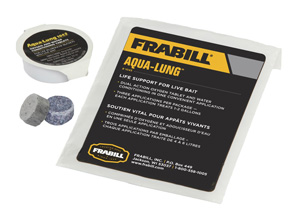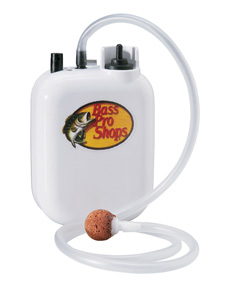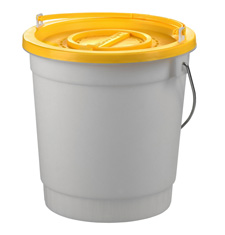
| Bait buckets help keep bait healthy and alive, which increases chances of it attracting fish. |
In fishing, sometimes the subtleties can make the difference between a good and a bad day on the water. Nowhere is this truer than when using live bait. Of course, if you locate aggressive fish, sub-par bait might not make a difference; however, when enticing neutral or negative mood fish to bite, having healthy bait is a must. Portable bait containers are crucial to keeping bait fresh during short-term storage, in transport, or when fishing. In today's market, there are containers and materials to keep various types of bait, from minnows to leeches and from grubs to bugs.
Why Keep Fishing Bait?
Lively and healthy bait struggles on a hook, attracting the attention of nearby fish. In many instances, the allure of fresh bait is better than sickly bait. Sometimes it's easy to pick up bait at a tackle shop on the way to a honey hole, but in other cases you'll need to transport bait over long distances or keep bait fresh for days - this is where it pays to have the proper tools to care for critters. The good news is that the products are available and it doesn't require a lot of gear or energy to store bait.
Controlling Live Fishing Bait Conditions
Keeping bait fresh and healthy is the result of successfully controlling the conditions to create a suitable environment. For example, if you neglect to keep grubs dormant in a cold, dark place and don't check on them for a while, they might have changed into flies. When keeping any live bait the basic factors to consider are: temperature, moisture, oxygen, light, and space. Fail to keep the above-mentioned elements in the proper range and the bait will eventually die. (Food is rarely an issue for short-term storage and feeding bait often complicates balancing the other factors.)
The good news is that most portable bait containers are designed to help you control environmental factors for specific types of bait, often based on their habitat (such as buckets for minnows and cages for crickets). These containers serve as temporary holding spaces, but some can be used to store bait for several days or weeks. Accessories and materials for bait containers (such as air pumps for buckets and bedding for worm boxes) increase your chances of successfully keeping bait and balancing environmental conditions. Some common portable bait containers are: buckets, worm boxes, leech totes and insect and grub carriers.
Fishing Bucket Basics
 |
| You can turn any bucket into a temporary "bait bucket" with aerator tablets such as these. |
Many anglers were introduced to fishing by using live bait and a trusty bucket was often the container of choice to carry anything from minnows, crayfish, to frogs. The most basic buckets feature a handle and a lid, often with air holes. There are also dozens of options associated with bait buckets. Most are made of hard plastic, but some models are available made of soft plastic and can be collapsed when not in use. Insulated foam buckets are another option, and traditional galvanized steel bait buckets are still found in many tackle shops.
Most lids have air holes and also feature a smaller, secondary, snap-open door. The door lets you add or remove bait while keeping the main lid on the bucket, reducing the chance of escapees. Other features to look for in bucket lids are notches, holes, and clips for holding fishing accessories, such as: dip nets, aerators, air hoses, and pliers. These lids keep anglers organized when moving between spots during a day's fishing. Additionally, some buckets also serve as a seat for fisherman. These models come in taller versions (usually 6 gallon) with a padded foam lid for a cushioned seat.
Another common feature in bait buckets is an inner bucket, or liner, that snugly fits inside the outer hard plastic case. Inner buckets are sometimes perforated, resembling a strainer. This lets anglers easily select bait from the liner after it's been lifted out of the outer bucket and the water has drained. Once bait is selected, the liner can be returned to the outer bucket. This system wastes little water and is particularly useful when using crayfish, as they're easier to grab out of water.
Foam liners are also common in bait buckets. These insulating liners keep minnows cool in warm months, but also reduce the freeze-rate of bait water in cold temperatures. The dimpled surface of the foam traps air bubbles, keeping water oxygenated; however, over time liners become dirty and need to be cleaned with a fine-grit sandpaper and water to return their micro-pocketed qualities.
A Bucket's Buddy: Aerators
Investing in a quality aerator will quickly pay for itself by reducing your bucket's death rate when keeping minnows or other aquatic bait (such as shrimp). Portable aerators have gone from basic items to more sophisticated units sporting extra features. Portable models run on batteries, using sizes from AA- to D-cells as well as some that hook up to 12-volt batteries. The majority of portable aerators feature clips for attaching to bait bucket lids and most come with air hoses and air stones. An On/Off switch is another feature to look for, and some models have low and high output levels.
 |
| Aerators help keep aquatic bait alive longer and can be attached to bait buckets or come with it. |
More advanced features in aerators include quality air hoses that won't kink or get brittle in cold conditions, as well as high oxygen-output air stones. The latter put out more air bubbles than regular stones and really make a difference in the water's oxygen level. Some aerators have a built in light. Helpful in low light conditions, they make selecting and hooking bait easier instead of fumbling with a flash light.
Anglers wishing to store bait for several days should look at investing in a plug-in aerator. These units allow you to run an aerator for days whether in your garage or at a weekend cottage. Tackle manufacturers sell models, but savvy anglers can save a few pennies by purchasing a simple air pump at a local pet shop. Air stones and air hoses can also be purchased at pet shops. When storing bait with plug-in aerators, always keep the pump above the bucket's water level. If the pump is below the bucket and there's a power failure, water can siphon through the air tube and drain from the bucket, killing bait and causing damage. Don't store the aerator on the lid either. Lids are often slightly rounded and the pump's vibrations will likely cause it to fall off the top.
Fishing Leech Tote
A variation on the standard bait bucket is a leech tote. These carriers can either be designed to sit in a boat's live well (which could also be included in a big bait bucket) or function as stand-alone unit. Units often come with a handle and feature small holes for aeration and drainage. Most are made of hard plastic, although mesh bags are also available. Keeping leeches cool and protected from bright light will keep them healthy.
Worm Containers
There are a variety of options for keeping worms in good condition when fishing. One of the first items to look for in a worm carrier is a snug-fitting, lockable lid. Leave worms even the smallest crack and they'll crawl through it. Containers are usually made of an insulating material, often foam, although some models feature materials that can be soaked in water to keep worms moist and cool during the day. Portable models sometimes feature holders for ice packs to keep crawlers cool. One or two access doors or handles are other features to look for in a container.
A common conundrum when keeping worms is choosing what material to store them in. Dirt does me fine when I'm grabbing a dozen from a local tackle shop on my way to a fishing spot. I usually bring a cooler with ice packs to keep worms cool during the outing. Of course, the downside to this set-up (and any time you keep worms in dirt) is that the dirt always seems to find its way onto clothing and boat carpeting. Although a quick worm-rinse before hooking can prevent a lot of mess. Another option is transferring worms (rinsed in water first) into worm bedding, available at most tackle shops. Bedding should also be used when storing worms for long periods in larger boxes. Additionally, keeping worms in bedding makes temperature and moisture regulation easier.
Insect Carriers
 |
| Insect cages are often made of a wire or plastic mesh and are shaped as squares or tubes. |
Crickets and grasshoppers are insects used by anglers and there are portable cages for carrying them when fishing. Cages are often made of a wire or plastic mesh and are shaped as squares or tubes, with larger wire buckets also available. Some units have funnels at their openings so hoppers can be removed one at a time, eliminating escapees. Some funnels also have a grabber at the end that'll hold the insect in place, letting you hook it while it's immobile before fully removing it from the container. Containers also feature handles to make carrying easy.
Grubs are one of the hottest baits on the ice fishing scene. They fool panfish as well as larger biters, like walleyes. Anglers can use various household containers (like film cases to small Tupperware boxes) to transport waxworms, mealworms, and wigglers. Of course, pocket-sized, commercial models are also available with most containing a sorting device to help sift through sawdust and bedding, quickly delivering bait to one's fingertips. Manufactured carriers contain tight-fitting lids and snap-shutting doors. The availability of grubs, containers and bedding will depend on your area and local suppliers; however, don't be discouraged if your tackle shop doesn't supply this live bait, as you can order grubs and worms from large tackle distributors along with accessories and materials. Another option is to look in pet stores, as many worms and grubs are used to feed reptiles and amphibians.
As anglers, we get enough challenge chasing our quarry, and don't need extra obstacles when it comes to keeping live bait. Luckily, today's market is full of portable options for holding aquatic and terrestrial bait that won't interfere with fishing adventures. Bait buckets, leech lockers, worm totes, cricket cages, and grub carriers are all designed to safely hold bait and make transporting it an easy task. If you've been using the same minnow bucket for years, or have yet to invest in a decent worm tote, consider purchasing a new model. Newer units are full of features that make live bait transport and short-term storage a simple and easy task.
- 15903 views


